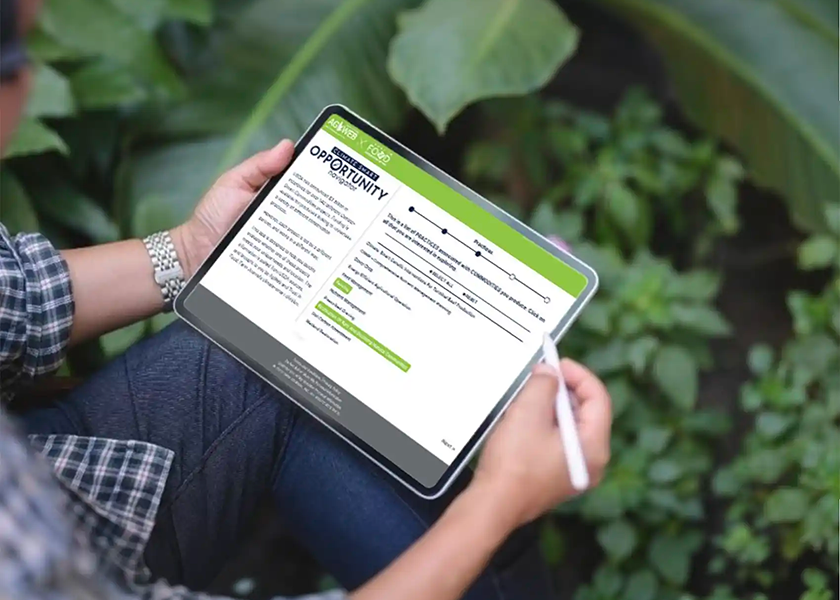Want to Avoid Leaving Climate-Smart Money On the Table? There's An App for That

In 2023, USDA’s Partnerships for Climate-Smart Commodities turned on the spigot to fund 141 projects, totaling $3 billion. Understanding the projects — each run by a different organization with its own unique offerings and structure — begs the question: Is it possible to have too much of a good thing?
“Producers are always interested in looking at opportunities, but we can’t review 141 grants,” says Jimmy Emmons, western Oklahoma rancher and Trust In Food vice president.
To cut out the time-consuming task of wading through the climate-smart projects, a new app pilot, the Climate-Smart Opportunity Navigator, seeks to remove the paperwork clutter and match farms and ranches with the right Climate-Smart Commodity grant project in minutes.
“Quicker and more efficient means to evaluate opportunities will increase participation, offer simple communication avenues, and, ultimately, get funding into the hands of growers so they can quickly turn those dollars into applied practices,” says Joelle Mosso, Western Growers Association associate vice president of science.
How Does the Climate-Smart Opportunity Navigator Work?
The app pilot, created by Farm Journal’s Trust In Food and AgWeb, is powered by USDA data on the 141 projects, most of which are focused on major commodities such as corn, soybeans and livestock. Harnessing this data in an app, producers can input their operation basics – such as location, commodities produced, and production practices and interests – and be matched with one or more of the Climate-Smart Commodities projects that fit their individual specs.
The app provides a basic description of each program match along with contact information so it’s easy to compare options and take the next step to participate.
For example, an Indiana corn grower interested in adopting no-till and cover crop practices would input their data to the Climate-Smart Commodities Opportunity Navigator. In four questions, the tool matches the farm’s profile and interests with 11 possible grant projects, such as:
-
Field to Market’s “Climate-Smart Agriculture Innovative Finance Initiative”
-
National Fish and Wildlife Foundation’s “Farmers for Soil Health Climate-Smart Commodities Partnership”
In contrast, a Colorado beef and bison producer looking to adopt prescribed grazing and soil health improvement practices on pasture would input their information to the Navigator tool and it matches the farm’s profile and interests with 9 grant projects that includes:
-
American Sustainable Business Institute Inc.’s “The Growing GRASS Project”
-
Sustainable Northwest’s “Building a Regenerative Ranching Economy in the West”
A Pennsylvania dairy producer interested in adopting nutrient management and cover crop practices matches with 9 grants, such as:
-
Truterra LLC’s “Climate SMART (Scaling Mechanisms for Ag’s Regenerative Transformation)”
-
Dairy Farmers of America, Inc.’s “Scaling Methane Emissions Reductions and Soil Carbon Sequestration – A Value-Added Commodities Approach for U.S. Dairy”
And an Indiana pork producer who practices feed management and integrates cover crops matches with 2 grant projects:
-
Fischer Farms Natural Foods LLC’s “Fischer Farm Ultimate Beef and Pork Strategy”
-
Farm Journal’s “The Connected Ag Project”
Big Picture: The Perfect Climate-Smart Project Isn’t One-Size-Fits-All
“It’s great there are lots of opportunity for producers with USDA’s Partnerships for Climate-Smart Commodities, but with so much opportunity it can be very overwhelming,” says Andrew Lyon, Trust In Food’s director of technical assistance and Kansas rancher. “By putting in specific information about your operation, the Navigator tool allows you to whittle down grant opportunities to the handful that are most applicable to you and provides you contact information so that you could follow up with those few opportunities that best suit you.”
While Farm Journal is excited about its own $40 million Climate-Smart Commodity grant, The Connected Ag Project, it wants producers to get in touch with the opportunity that best suits them, Lyon adds.
Test Drive the Climate-Smart Opportunity Navigator Tool
Farm Journal’s AgWeb and Trust In Food look forward to hearing from producers about their experience using the beta version. Take the Climate-Smart Opportunity Navigator for a test run, and let us know what worked and what didn’t.
USDA’s Climate-Smart Commodities, Explained
In 2021, USDA announced a historic investment in farmers, ranchers and private forest landowners through a program dubbed the Partnerships for Climate-Smart Commodities. The goal? To scale climate-smart agricultural production practices across the U.S. and to promote and market climate-smart commodities in thriving markets.
To do this, over the next 5 years USDA is financing 141 pilot projects to support the production, tracking and marketing of these climate-smart commodities.
While the specific Partnerships for Climate-Smart Commodities grant projects vary widely, each boil down to putting financial incentives or technical support directly into the hands of U.S. farmers, ranchers and landowners to produce and market climate-smart agricultural commodities.
While the term, “climate-smart commodity” is relatively new, the farming and ranching practices it describes have, largely, been around for much longer. Incorporating cover crops, grazing and rangeland management, prairie restoration and nutrient management are just some of the practices that fall under the climate-smart umbrella.
For many producers, participating in a CSC grant translates to getting credit and even cash payment for practices already in place on farm. What’s more, for producers seeking funding sources or simply a push to try something, new these grants are an opportunity to make a change with support along the way.







